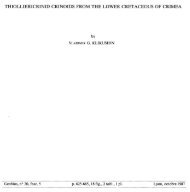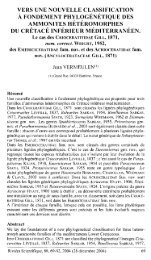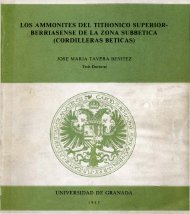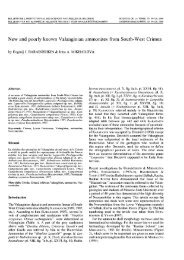peter franklin rawson, dennis curry, frank charles dilley, john michael ...
peter franklin rawson, dennis curry, frank charles dilley, john michael ...
peter franklin rawson, dennis curry, frank charles dilley, john michael ...
You also want an ePaper? Increase the reach of your titles
YUMPU automatically turns print PDFs into web optimized ePapers that Google loves.
calcareous-argillaceous successions of the Vocontian trough, ammonities are muchmore common and it is here that Kilian and co-workers established the ‘standard’Tethyan zonation, in which the Valanginian was divided into two zones, theKilianella roubaudi Zone below and the Saynoceras verrucosum Zone above.Thieuloy (1973) has now proposed a more detailed scheme, as follows:Upper ValanginianLower ValanginianNeocomites (Teschenites) callidiscusHimantoceras trinodosumSaynoceras verrucosumNeocomites campylotoxusKilianella roubaudiThurmanniceras pertransiensThe Lyons Colloquium (Barbier & Thieuloy 1965; Debelmas & Thieuloy 1965)recommended that a Valanginian parastratotype should be erected, based on asection in the Vocontian trough and preferably in the region of the Hautes-Alpes.The majority of the ribbed ammonites of Tethys are neocomitids or olcostephanids,whereas the boreal Valanginian (especially in the Soviet Union, easternEngland and east Greenland) is characterized by a sequence of Tollia-like forms,followed by polyptychitids. In the north German Basin, early Valanginian tolliids arelargely replaced by Platylenticeras, index genus of the Platylenticeras Schichten(which overlie the non-marine Biickeburg Formation of Casey et al. 1975). Insouth-east France, species of Platylenticeras characteristic of the lowest PlatylenticerasSchichten occur in the pertransiens Zone (Thieuloy 1973), thus providing afirm correlation for the base of the Valanginian. Limited correlation betweenGermany and France and England and France can be made also at higher levels(Kemper 1973a; Rawson 1973; Thieuloy 1973).Small, septate specimens of Paratollia, Propolyptychites, Menjaites and Platylenticerasoccur in D4 at Speeton (e.g. Rawson & C. W. & E. V. Wright’s collections),and rare Paratollia, Propolyptychites and Pseudogamieria in the basal Claxby Ironstoneof Lincolnshire. Thus the English early Valanginian faunas provide a link withboth the Platylenticeras Schichten of North Germany and the Pseudogamieriaundulatoplicatilis Zone at the base of the Valanginian of the Russian Platform.The higher part of the Valanginian of northern Europe and Arctic regions yieldsabundant polyptychitids: at Speeton Polyptychites appears at the base of Bed D3 andextends to the top of D2E, and the same genus is common in the bulk of the ClaxbyIronstone and in the Hundleby Clay. None of the material has been collected in thedetail necessary to establish a zonal succession comparable with that of the northGerman succession, and we recognize therefore only a broad Polyptychites Zone.Our Upper Valanginian zonation is a simplified version of the German zonation (seeKemper 1973a), in which the unnamed zone at the top corresponds with theAstierien Schichten of earlier authors, for which a satisfactory zonal index has yet tobe selected. The Upper Valanginian zones are represented by a remanie horizon atSpeeton and by more or less condensed levels in Lincolnshire.
















